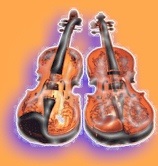 The seven songs on the follow-up to the typewriter-named Nashville duo’s Radio Hymns, continues its concept theme of of songs inspired by Nashville’s lost history, this time as a companion piece to Vanessa Olivarez and Elizabeth Elkins’s first book, Hidden History Of Music Row.
The seven songs on the follow-up to the typewriter-named Nashville duo’s Radio Hymns, continues its concept theme of of songs inspired by Nashville’s lost history, this time as a companion piece to Vanessa Olivarez and Elizabeth Elkins’s first book, Hidden History Of Music Row.
Tiny Televisions opens with the throaty staccato guitar riff and heavy drums of the title track, a number about the Little Sisters Home for the Poor, a 60s-era nursing home on 17th Avenue, that was once a chapel for Catholic nuns before becoming a retirement home where the elderly residents sat on the floor and watched outside events (the moon landing, the Vietnam War, JFK and MLK’s assassination, Beatlemania) reported on television and others committed suicide by jumping from the top floor.
A more muted sound with keys and spectral guitars colour ‘Ice Cream’, a number which, sung in the first person, recounts the story of Sarah Estell, a freed slave who, in 1855 was one of the city’s first African-American business owners, owning an ice cream shop at 39 Summer Street in downtown Nashville prior to the Civil War. At the time it was only affordable to the white wealthy and (belying the suggestion of hostility in the opening lines “they don’t like the taste of my name burning on their lips”) as such she catered to many political, church and civic events, though the song plays as a skewed love song.
Getting Southern funky, ‘Getaway Car’ travel through hard living outlaw country for a song about getting high(“we’re all poets and strangers amphetamine saviors/forgivers and takers”) that draws on the arrest of Waylon Jenings on August 23, 1977 by the DEA in his studio on charges (later dropped given they’d flushed the evidence down the toilet) of possession of cocaine with intent to distribute.
It then arrives in ‘Hell’s Half Acre’, which, set to a steady drum beat and organ backdrop, details a long-forgotten predominantly African-American slum neighbourhood in the lowlands north and west of Capitol Hill that got its name as a result of the numerous fights and shootings that took place there during the 1870s and 1880s. It was razed in the 1950s to build Robertson Parkway and Bicentennial Park, the song ending with the line “blow me over keep burying me/the trick of mud and water is how deep you sleep”.
From the city’s African-American heritage, the piano and organ-led ‘Monsters In The Stars’ turns to that of Native Americans, keening pedal steel colouring its reference to the Trail of Tears, the forced relocation of 60,000 of the First Nations population by the Indian Removal Act in 1830. In May 1838, 16,000 of them were rounded up outside Chattanooga for a forced march to Oklahoma territory, the route passing over the Cumberland River at Nashville, using the Nashville Toll Bridge, 4,000 of whom died along the way and who haunt it still as they sing “I walk above looking-glass water the reflection that I see / is another broken mirror another place that’s not for me”. Today it’s “gravel brick and stone like we were never here/still drowning in the memories on the Trail of Tears”.
Finally, again bolstered by a steady drum thump, they turn up the twang for ‘Opryland’, a song about “being brave again” inspired by the death of country legend Dotie West who, when her car broke down en route to perform at the Opry, was given a lift by her octogeneraian Nashville neighbour George Thackton who, having been drinking, lost control of the speeding vehicle as he exited Briley Parkway, West, who believed she was going recover, subsequently dying on the operating table some days later due to internal injuries.
A terrific addition to your Americana library and fascinating history lessons too, switch on and tune in.
Mike Davies
Artists’ website: www.granvilleautomatic.com
‘Tiny Televisions’:
 Thanks for stopping by. Please help us continue and support us by tipping/donating to folking.com via
Thanks for stopping by. Please help us continue and support us by tipping/donating to folking.com via
You must be logged in to post a comment.